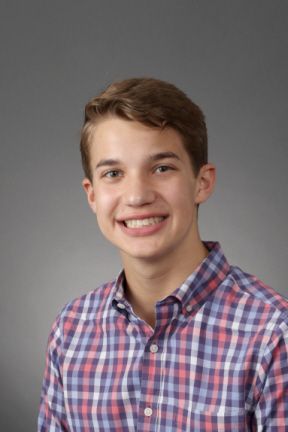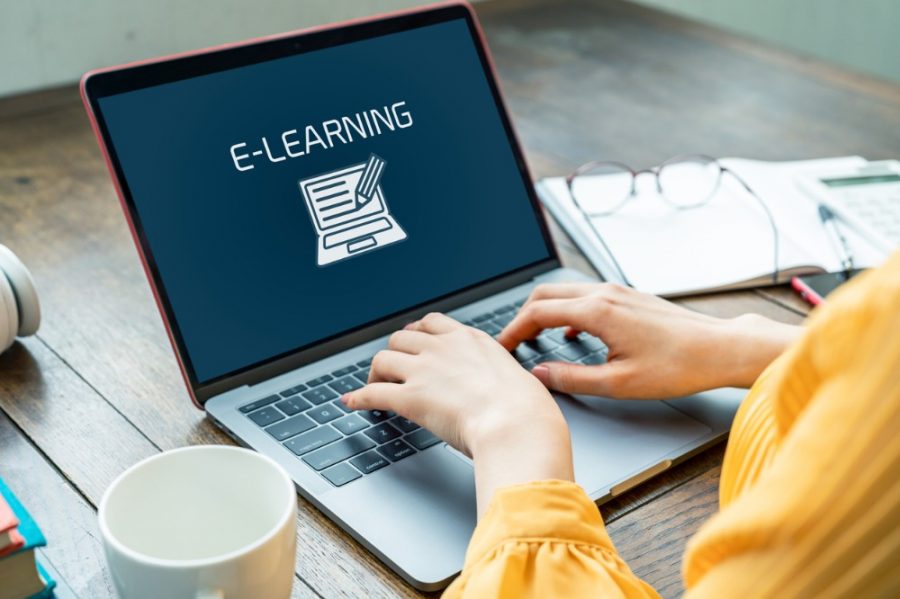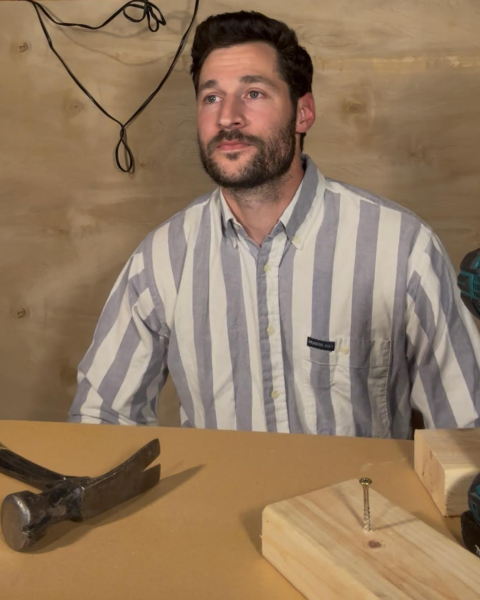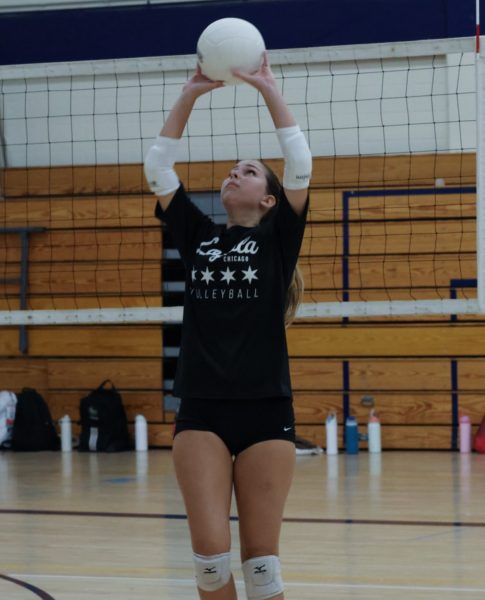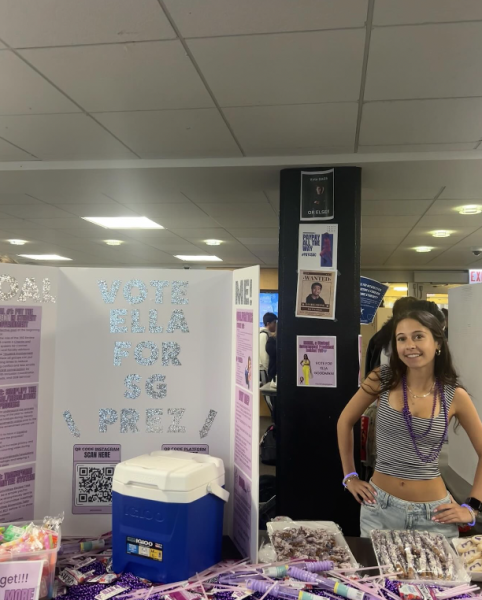Going Back? Yes And No
School Divisions Return In Different Forms
Photo credit: Google Images
Laptop displaying “E-Learning.” Photo courtesy of Google Images, fair use.
On March 13, 2020, Illinois Governor J.B Pritzker closed all Illinois schools until March 30, as a result of the COVID-19 pandemic sweeping the globe. Five weeks later, Pritzker closed all Illinois schools for the rest of the school year. Not only were students around the state surprised, but administrators were forced to focus both on finishing the current school year and looking forward and planning for the upcoming fall semester of classes.
In July, the Parker administration sent an email to all faculty members and families detailing the plan for students to return to campus amidst the coronavirus pandemic. While JK-8th graders got the go-ahead to return, albeit with several restrictions to assure their safety while on campus, the plan for Upper School students to return was pushed back until health officials deemed it safe to do so.
After school concluded for the 2019-2020 school year in June, members of the Upper School faculty met to discuss modifying the remote learning schedule when it became apparent that the coronavirus would not be gone by September. “We looked at the spring schedule, we also looked into the feedback we received from students and faculty and parents, and thought about ‘how can we make it a little bit more Parker-like, and how can we make it a better overall experience for everyone?’” Head of Upper School Justin Brandon said.
At the beginning of August, the team created a draft of the remote learning schedule based on student and teacher feedback. Academic classes (A-F Block) would now meet three times a week, faculty created a U-Lunch period, and other school wide activities, like Student Government and Graderoom, were given their official time slots.
The administration created the schedule with feedback from the Upper School Council, a collection of teachers and students who give their opinions on matters in the Upper School. “The way they produced the schedule was: kids asking questions and voicing their opinions, and then in the end, the faculty and the administration decided what they thought was best, obviously following the guidelines that they got from the state,” senior and Upper School Council member Ethan Butler-Vanderlinden said.
While each member of the council had a different reaction to the schedule, Butler-Vanderlinden enjoyed the change of pace. “I think everyone had their own reaction, at least my reaction was, ‘I think it’s good.’ I obviously think we should go back to school but schedule wise, it has not too much but just enough classes,” Butler-Vanderlinden said. “I think doing three classes instead of two will also make it more work but make sure people aren’t slacking off.”
On July 10, the Upper School administration announced that a hybrid schedule had been created for all grades to come back, but later changed it to remote learning for Upper School on July 31. “The way that the pandemic has hit our city and hit the world, everything has kind of been day-to-day, and at that time, we said ‘sure that makes sense, let’s see if we can make that work,’” Brandon said. “One thing I have been telling people and how this planning has worked is we’re thinking about the health, safety, and educational experience for our community. And everything has been grounded in those three aspects.”
Brandon later realized that the hybrid schedule, while possible, would not work for the Parker curriculum. “In this kind of situation, we thought about, ‘what’s actually more Parker, which idea is more Parker in this?’” Brandon said. “Desks in rows, everyone having to face forward, everyone wearing a mask, teachers standing in the front of the room, not able to comfortably walk around the room the way they would, and limiting student interaction even within the classroom.”
These factors, as well as the safety guidelines given to the administration by health officials in Chicago, showed that Upper School should go remote. “When I take all that into account and also thinking about the space, it just made more sense that we try to shift into remote learning,” Brandon said. “I mean, yes, there are other factors. People have asked, ‘what about a hybrid schedule where two grades come in on Monday and Tuesday and the other two on Thursday and Friday?’ And we’ve looked at that as well. The challenge with that is exposure. Because we have 330 unique and individual schedules, no two students have the same schedule, which means we can’t cohort our students in the way that Middle School and Lower School can.”
The question of how remote learning affected different age groups soon came up in discussions about reopening. “When you factor all of that in and thinking about which age level is more ready for the independence of online learning, is it an 18-year-old or a 7-year-old?” Brandon said. “And it’s a horrible question to ask because it’s still not good, but thinking about the priorities that we need to place on our community, it’s not what’s better for the age group, it’s what students can handle that instruction, versus which of those cannot.”
After the decision was made, Brandon emphasized how much planning and thought went into going remote. “Going remote was the hardest decision we had to make. I think a lot of people assumed that it was the easy decision, and I had taken the easy way out, but I can’t tell people enough how much time we’ve thought about this and talked it through,” Brandon said. “We’re hoping that we’re able to plan for some in-person opportunities for students, but even those have to be really careful, and we have to be really measured with that approach.”
Some Upper School students, though they understood the rationale, were disappointed with the switch to remote learning. “I was very frustrated that, it wasn’t that they lied, it’s a constant changing thing, but they kind of told us one thing, got our hopes up,” Butler-Vanderlinden said. “I thought it was frustrating for me, but I understood why they had to do it, because they’re trying to keep the spread of the virus slow.”
The Intermediate and Middle School can work within the restrictions to create an in-person schedule. “We literally went through the building, room by room, to see which spaces do we have that can hold 18 students, with a teacher and an assistant teacher if necessary, with six feet minimum of social distancing,” Head of Intermediate and Middle Schools John Novick said. “We found that we have the physical space if we reinvent how spaces are used to do it. Temporarily, with COVID-19, middle school students don’t transition from class to class, the teachers come to them.”
Novick found that it was more feasible for IS and MS students to return due to their non-flexible schedules. “In Middle School, in Intermediate School, we have sections. High school kids take classes across grades, so the fact that a high school schedule is not based on what grade you’re in, and the fact that the high school students are larger and take up more physical space to get the social distance we need, it really makes it almost impossible,” Novick said. “Without sections or pods, there’s no way to reduce the number of kids you come in contact with.”
With schools closing around the United States, the possibility of all Parker students going remote has been considered. “As it stands now if we went from Phase Four to Phase Three, Phase Four says the maximum number of human beings that can gather is fifty. We’re not gathering fifty anyway, but the maximum number you can do in Phase Three goes down to ten,” Novick said. “And so I don’t see how our Middle School could return to campus full-time if I can’t put more than ten human beings in a room.”
The administration does not have one centralized statistic that they are basing the return to school on, but they are using all available data to make their decision. “There is no magical number. We may have one eventually, but there isn’t one now,” Novick said. “That doesn’t mean we’re not basing everything on the data. There’s just a lot of data points to reference.”
Novick has spoken with parents to gauge their thoughts on their children returning to Parker amidst the pandemic. “I would say probably about 80% of the families that I have spoken to are feeling pretty comfortable about a student returning to campus with all the safety protocols, mitigations, and changes to the program in place, assuming Illinois is in Phase Four,” Novick said. “And about 20% have deeper questions and are worried and are considering maybe having their child come back remotely, or have already signed up to do so. We have created optionality, where there will be a password-protected interactive video login via Zoom or Meet for kids to have a machine at the back of the room and be present in the room virtually.”
The goal of returning, even if it is for a short while, is to make a connection with new students in the meantime. “We’re confident we can cut through all the PPE and limitations and make a human connection with the Middle and Intermediate School kids so that we will know them better when and if we go remote,” Novick said.
Similar to Intermediate and Middle School, there is no specific metric that will determine whether the Upper School can go back to campus in the future. “The world is different every day. When we think it is safe for the Upper School to come back, we will try to figure that out and get everybody back in the building in a way that they are comfortable and confident to return to the school building,” Brandon said. “It really depends on the science. One of the benchmarks we’ll consider is seeing where we are in the middle of October, to see if a November return to campus makes sense, that’s one area that we’ll start to look at, but it’ll be up to science.”
Despite the modifications to remote learning, parents and students have expressed their concerns to Brandon over Upper School students not returning to campus. “It’s a disappointment, which is fair,” Brandon said. “Our job now is to help people fully understand the rationale of how we got here and how we’re going to make the best Parker experience we can, in this kind of area, but also reminding people, we’re in a national pandemic.”
